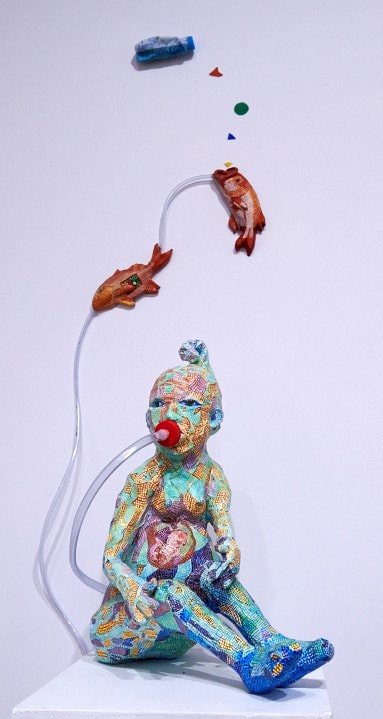|
CHRISTINE BAKER
Micro Plastic Menu papier mache, air dried clay, plastic, acrylic paint 184 x 84 x 46 NFS I was inspired by a talk on micro plastic contamination in the ocean by Dr. Harriet Paterson a Marine Biologist at UWA’s Albany Campus. Micro plastics can be ingested by zoo plankton and potentially transferred through marine food chains. Micro plastics consumed from these marine food chains by expectant mothers could damage the immune system of the developing foetus. REFERENCES Conservation Council of Western Australia. June 2017. Synthetic fibres dominate micro plastic pollution of South Western Australia. More than 200 Western Australian beaches have been sampled in the first project to provide information on micro plastic distribution across south west WA. The results of the community based program indicate that micro fibres are the major component of micro plastic marine pollution of our coastline and hotspots for contamination include Scarborough Beach and Green Head. Micro plastics are fragments less than 3mm. in diameter and samples with 13 of more micro fibres in every 100g of sand are micro plastic hot spots. The greatest no. of micro fibres found was at Scarborough Beach with 51 micro fibres found in every 100g of sand. C.C.W.A. micro plastic coordinator Kate Born said “These fibres are very easily eaten by small fish, plankton and other creatures at the bottom of the food chain.” As it drifts in the ocean, a fibre’s surface gets coated in mercury and D.D.T. These chemicals build up and a single micro fibre can become super concentrated- up to 1,000 times more toxic than the surrounding ocean water. These chemicals can bioaccumulate through the entire food chain, potentially causing dangerous health affects to marine animals and humans. The most direct source of micro fibres is fishing lines and nets. Through every day use, micro fibres break off in the 1000s from a single net or line, directly into the water. Another source is synthetic clothing. Every time we wash a single article of clothing thousands of micro fibres are released into the water system and end up in the sea. The solution is to buy natural fibre instead. Dr Harriet Paterson a marine Biologist at the University of WA’s Albany Campus extracted the micro plastic collected by citizen science volunteers and conducted the analysis. Dr Paterson believes the microscopic plastic fibres in beaches are an indicator of local marine contamination. The beaches of the South West had 0-5 micro fibres in every 100g of sand as the background level. Some were between 6-12 micro fibres per 100g of sand, with remaining sample 13 or more. These micro fibres can, along with other micro plastic particles can be ingested by zooplankton and potentially transferred through marine food chains. Some components of plastic. Some components in plastics, such as phthalates are hormone disruptors in animals. Over 270 marine species are known to be negatively affected by plastic waste, though the exact number from micro plastics is undetermined. BIO SUMMARY Christine Baker was born in Denmark, Western Australia. She is a Kendenup based artist and finds expression in paint, clay and various other media. Christine achieved a TAFE preliminary certificate in Art and Design but is largely self- taught. After working for many years in vineyards and shearing teams, her focus is now on full time art. Christine has won numerous awards, mainly for painting. Her work often forms narrative threads addressing the environment and the human condition. |
